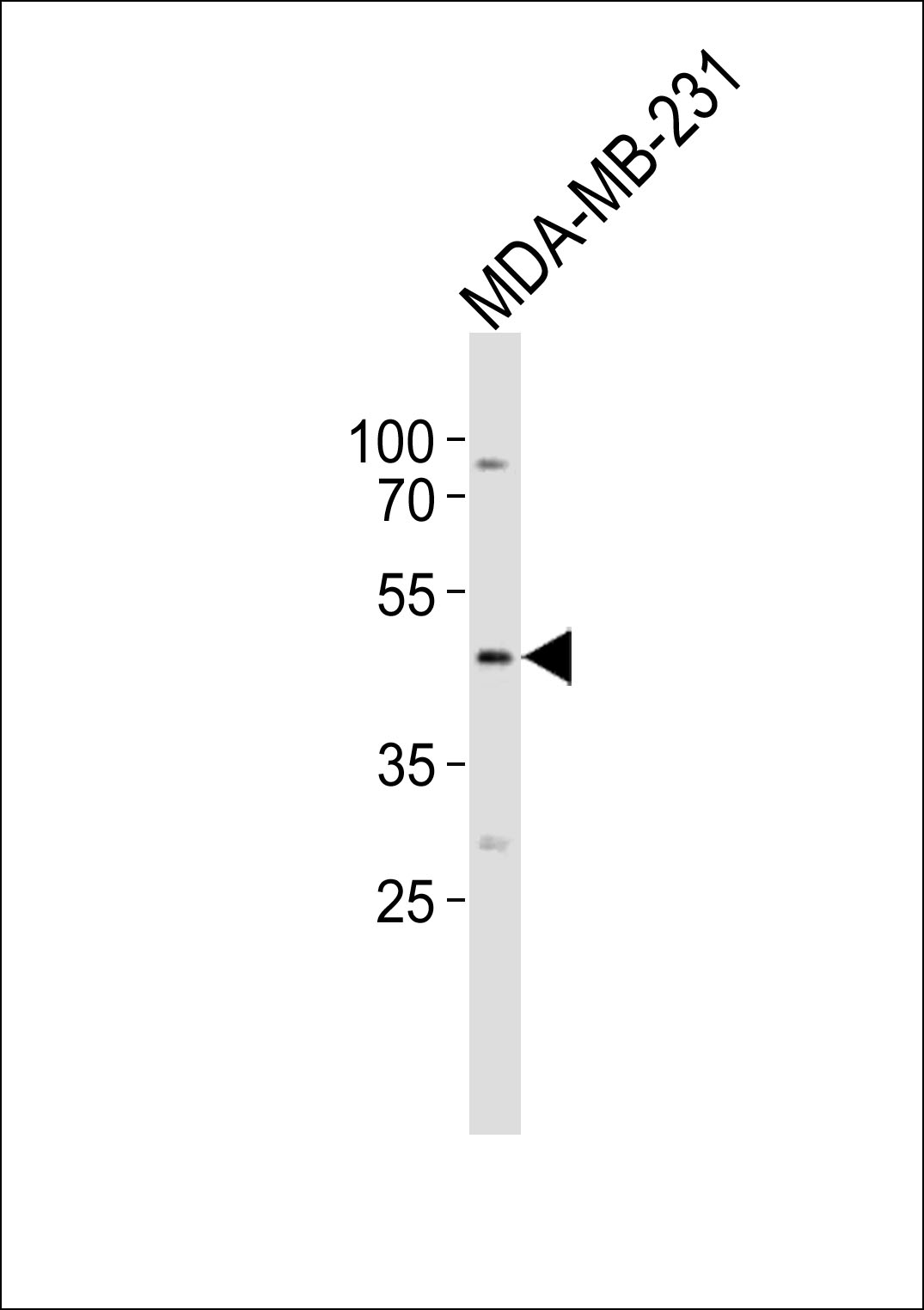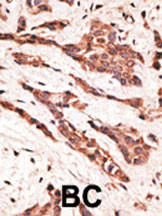EDG4 Antibody (N-term)
Purified Rabbit Polyclonal Antibody (Pab)
- SPECIFICATION
- CITATIONS: 5
- PROTOCOLS
- BACKGROUND

Application
| WB, IHC-P, E |
|---|---|
| Primary Accession | Q9HBW0 |
| Other Accession | Q95KH4 |
| Reactivity | Human |
| Predicted | Monkey |
| Host | Rabbit |
| Clonality | Polyclonal |
| Isotype | Rabbit IgG |
| Calculated MW | 38741 Da |
| Antigen Region | 3-32 aa |
| Gene ID | 9170 |
|---|---|
| Other Names | Lysophosphatidic acid receptor 2, LPA receptor 2, LPA-2, Lysophosphatidic acid receptor Edg-4, LPAR2, EDG4, LPA2 |
| Target/Specificity | This EDG4 antibody is generated from rabbits immunized with a KLH conjugated synthetic peptide between 3-32 amino acids from the N-terminal region of human EDG4. |
| Dilution | WB~~1:1000 IHC-P~~1:50~100 E~~Use at an assay dependent concentration. |
| Format | Purified polyclonal antibody supplied in PBS with 0.09% (W/V) sodium azide. This antibody is prepared by Saturated Ammonium Sulfate (SAS) precipitation followed by dialysis against PBS. |
| Storage | Maintain refrigerated at 2-8°C for up to 2 weeks. For long term storage store at -20°C in small aliquots to prevent freeze-thaw cycles. |
| Precautions | EDG4 Antibody (N-term) is for research use only and not for use in diagnostic or therapeutic procedures. |
| Name | LPAR2 (HGNC:3168) |
|---|---|
| Synonyms | EDG4, LPA2 |
| Function | Receptor for lysophosphatidic acid (LPA), a mediator of diverse cellular activities. Seems to be coupled to the G(i)/G(o), G(12)/G(13), and G(q) families of heteromeric G proteins. Plays a key role in phospholipase C-beta (PLC-beta) signaling pathway. Stimulates phospholipase C (PLC) activity in a manner that is independent of RALA activation. |
| Cellular Location | Cell surface. Cell membrane; Multi-pass membrane protein. Note=Prior to LPA treatment found predominantly at the cell surface but in the presence of LPA colocalizes with RALA in the endocytic vesicles |
| Tissue Location | Expressed most abundantly in testes and peripheral blood leukocytes with less expression in pancreas, spleen, thymus and prostate. Little or no expression in heart, brain, placenta, lung, liver, skeletal muscle, kidney, ovary, small intestine, or colon |

Provided below are standard protocols that you may find useful for product applications.
Background
EDG4 is a member of family I of the G protein-coupled receptors, as well as the EDG family of proteins. This protein functions as a lysophosphatidic acid (LPA) receptor and contributes to Ca2+ mobilization, a critical cellular response to LPA in cells, through association with Gi and Gq proteins.
References
Hu, Y.L., et al., J. Natl. Cancer Inst. 95(10):733-740 (2003).
Fujita, T., et al., Cancer Lett. 192(2):161-169 (2003).
Contos, J.J., et al., Genomics 64(2):155-169 (2000).
Zheng, Y., et al., FASEB J. 14(15):2387-2389 (2000).
Young, K.W., et al., J. Biol. Chem. 275(49):38532-38539 (2000).
If you have used an Abcepta product and would like to share how it has performed, please click on the "Submit Review" button and provide the requested information. Our staff will examine and post your review and contact you if needed.
If you have any additional inquiries please email technical services at tech@abcepta.com.














 Foundational characteristics of cancer include proliferation, angiogenesis, migration, evasion of apoptosis, and cellular immortality. Find key markers for these cellular processes and antibodies to detect them.
Foundational characteristics of cancer include proliferation, angiogenesis, migration, evasion of apoptosis, and cellular immortality. Find key markers for these cellular processes and antibodies to detect them. The SUMOplot™ Analysis Program predicts and scores sumoylation sites in your protein. SUMOylation is a post-translational modification involved in various cellular processes, such as nuclear-cytosolic transport, transcriptional regulation, apoptosis, protein stability, response to stress, and progression through the cell cycle.
The SUMOplot™ Analysis Program predicts and scores sumoylation sites in your protein. SUMOylation is a post-translational modification involved in various cellular processes, such as nuclear-cytosolic transport, transcriptional regulation, apoptosis, protein stability, response to stress, and progression through the cell cycle. The Autophagy Receptor Motif Plotter predicts and scores autophagy receptor binding sites in your protein. Identifying proteins connected to this pathway is critical to understanding the role of autophagy in physiological as well as pathological processes such as development, differentiation, neurodegenerative diseases, stress, infection, and cancer.
The Autophagy Receptor Motif Plotter predicts and scores autophagy receptor binding sites in your protein. Identifying proteins connected to this pathway is critical to understanding the role of autophagy in physiological as well as pathological processes such as development, differentiation, neurodegenerative diseases, stress, infection, and cancer.



